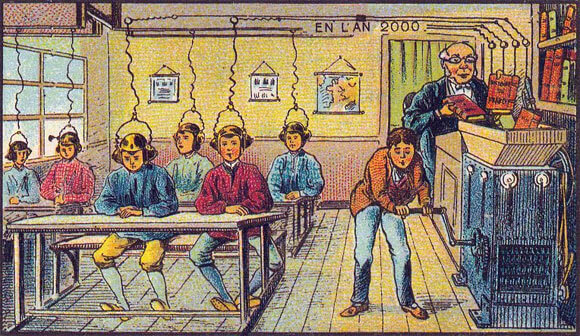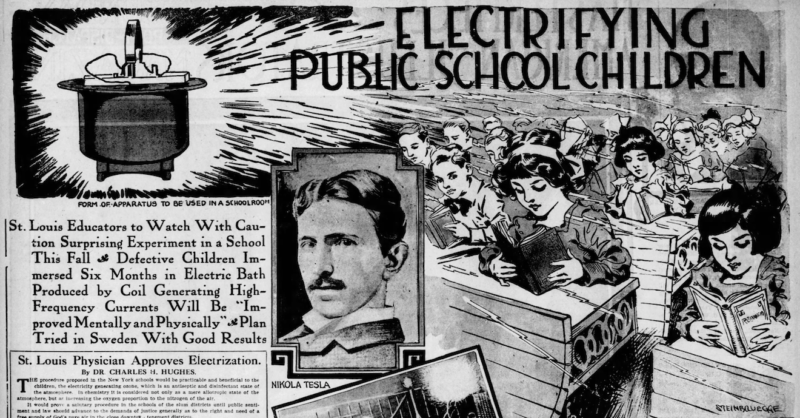A schoolroom full of young students sit attentively at their desks, hands folded before them. Each is wearing a headset whose coiled cable connects to a bus running in a conduit overhead that traces a serpentine pattern in the ceiling. Following the conduit, we see that it originates at the output of a large mechanical grinder. At one end of the grinder an elderly teacher feeds a stack of books into its giant maw, while one of the students turns the crank, converting the energy of the books’ contents into electricity and piping the knowledge directly into the students’ heads. It’s a fanciful picture, for sure, but not a bad vision of the future of education. Considering, that is, that it was painted in 1910! The artist, Jean-Marc Côté, was imagining the state of education, among other slices of life, in the year 2000.

Just fanciful imaginings? Maybe not. The book Moonshots details the surprising things this picture actually got right—and why its accuracy should be alarming today. On the heels of this, we discover a little-known but fascinating experiment whose basic idea is being realized today in equally fascinating ways. Here’s the story:
“This fall,” began the September 8, 1912, edition of St. Louis Post-Dispatch Sunday Magazine, “the first electrified schoolroom in America is to be fitted up in one of the public school buildings of New York. The teachers won’t know it. The pupils won’t know it. Only the men higher up in the school system and the scientists who observe and record the test will be aware of the electrification. For six months the experiment is to be in process. Then, if the results justify, other schoolrooms in the metropolis and elsewhere may be electrified.”

By “electrified,” the writer did not mean modernizing the classroom with lighting or other amenities—he meant quite literally bathing the students in a continuous wash of electromagnetic waves in order to make “dull pupils bright.” The brainchild of Nikola Tesla, the plan called for the installation of his Tesla coil, which in turn would drive the insulated wires installed in the walls of the schoolroom. “These wires,” Tesla explained, will be so carefully concealed as not to be noticeable to the pupils. Every effort will be made to keep the knowledge of the experiment from them. In general appearance the room will not differ from the ordinary bright, sunny, cheerful school room with its desks and other useful fixtures. A high frequency current of millions of volts will be generated in an apartment properly arranged for the purpose outside of the school room. When school begins, by simply turning a switch, the high frequency current will be turned on, by one of the instructors, and shortly afterwards the school room will become completely saturated with infinitesimal electrical waves vibrating at high frequency.”
The system promised, “Stupidity will be overcome. Mental lethargy will vanish. Backward children will be able to ‘get their lessons’ more readily. Their sluggish minds will be quickened, exhilarated, stimulated.” And the New York superintendent of schools bought in completely. It was also determined that the experiment would first be conducted on a class of “. . . mentally defective children, the most difficult of all pupils to handle, and the bane and trial of every school teacher’s life.” (The media reporting this story were certainly products of their time!)
While the system was built and installed in a New York classroom, the results of the test were apparently never published. However, a similar experiment was conducted in Sweden, where they did, in fact, claim that at the end of the test period, the children in the electrified room “. . . averaged 92 percent in their grades, while those in the other room averaged only 75 percent. Fifteen of the pupils exposed to the electric waves made 100 percent.” What’s more, the exposure to the electric field not only made the students smarter, but taller, too, with an average increase in stature of 2.5 inches, versus those in the control group whose average increase was but 1.25 inches. “The children in the electrified room,” the report continued, “showed increase in weight and proportionate physical development in excess of that of the pupils in the other room.” Moreover, the “electrified” children were reported by their teachers as appearing generally more active and less subject to fatigue, and of quickened mental faculties, while the teachers in the other room observed no such change. Pretty amazing!
So was this all just an early example of crackpot science, or was Tesla actually onto something? Well, if activity at DARPA is any indication, Tesla may finally get his due. The agency is funding development of a noninvasive headband (as opposed to Tesla’s ambient delivery) that modulates neural activity via weak, externally applied electric fields. DARPA is convinced that use of the device will make its wearers smarter by increasing learning by 40 percent. Called transcranial direct current stimulation (tDCS), it is already being used in therapeutic applications spanning stroke rehabilitation to cognitive enhancement. To enhance the learning process, DARPA-funded researchers first tested its effects on macaque monkeys, finding that the application of tDCS (2 mA) to the right prefrontal cortex did, in fact, improve their performance on an associative learning task. The study further demonstrated that it was the modulated connectivity between brain areas, not neuron firing rates, that accounted for the increased learning speed, confirming that tDCS leads to widespread changes in brain activity.
Researchers at Boston University have taken this idea a step further and tested it on humans. And indeed, tDCS demonstrably affected executive function, which led to a change in behavior, and showed how the cells in the medial frontal cortex and the lateral prefrontal cortex communicate with each other through low-frequency brain waves. Cheap, noninvasive enhancement. David Somers, a BU brain sciences and psychology professor, rhetorically asks, “Who doesn’t want to have their brain performance enhanced? This could produce the same effects as nootropics or smart drugs, but with fewer potential side effects, as the brain is stimulated directly. Having access to such a technology could be a game-changer.”
While tDCS may not make kids grow taller, at least it wouldn’t require a scary giant Tesla coil in the next room. In any case, Jean-Marc Cote’s fanciful projection of education in the year 2000 is suddenly looking a bit more credible.

